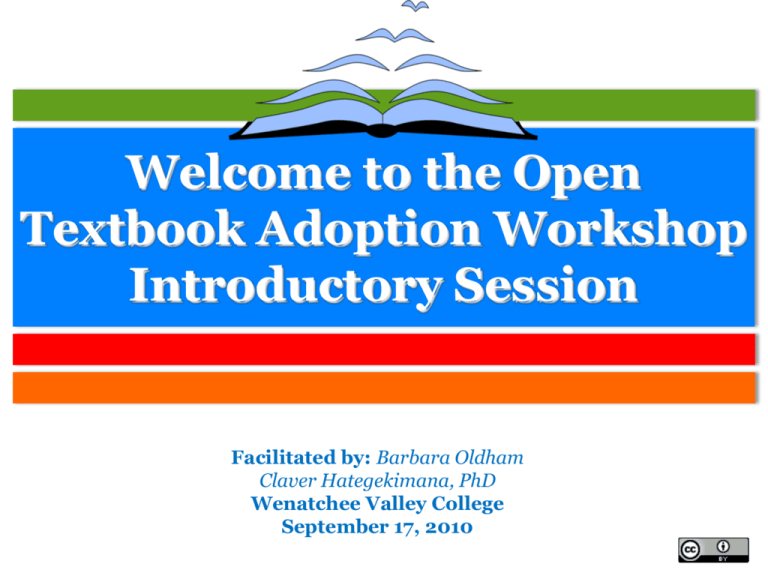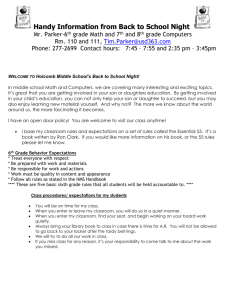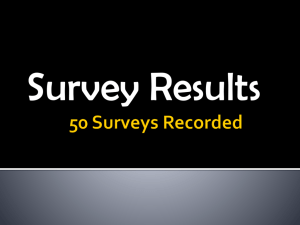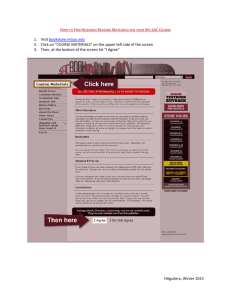
Welcome to the Open
Textbook Adoption Workshop
Introductory Session
Facilitated by: Barbara Oldham
Claver Hategekimana, PhD
Wenatchee Valley College
September 17, 2010
The Problem
High
Prices
New
Editions
used 5th edition
$81.78
The Problem
Prices
rising
4x
Inflation
rate
The Problem
Students
spend
$900 +
per year
The Problem
Part 1:
Flawed market
structure gives
publishers too
much power
Producer
Consumer
The Problem
Publisher
Student
Professor
The Problem
Publisher
Part 2:
Self-destructive
business model
drives publisher
market abuses
Bookstore
used books
Students
We need a solution that will:
1.Make the market more studentcentric, without undermining faculty
2.Rework publishing models to be more
efficient and sustainable
Solution:
Look beyond traditional textbooks
How many women and men?
Develop a culture of sharing
Federal Law:
Faculty and staff must consider the least costly practices in assigning course
materials, such as adopting the least expensive edition available.
Institutions must consider methods and open licensing options for effectively
sharing digital content
WA Registration SHB1025: Requiring colleges to share educational
technology and content
WA Registration SSHB1025: Requiring disclosure of certain information
relating to higher education course material, including textbook ISBN
Creative Commons – New Copyright Choices – Some rights reserved
“We need diversity of thought
in the world to face the new
challenges.”
“If you put together a
big enough and
diverse enough group
of people [.....] that
group’s decisions will,
over time, be
intellectually superior
to the isolated
individual, no matter
how smart or wellinformed he is”
~ Sir Tim Berners-Lee
http://thekaoseffect.com/
~ James Surowiecki
cc Steve Wheeler, University of Plymouth, 2010
Collective intelligence
Solution:
Open Educational Resources
Digitized materials,
offered freely and openly
for educators, students, to
use and re-use for
teaching, learning and
research.
Community College
Open Textbook Project Goal
Identify, organize, and support the production and use
of high quality, accessible and culturally relevant Open
Textbooks for community college students
Reduce the
cost of
textbooks!
Community College Consortium
for Open Educational Resources
Joint effort to develop and use open
educational resources and open textbooks
in community college courses
cccoer.wordpress.com
CCCOER Membership
Open resources initiatives
Open Courses of:
• Yale University,
• MIT,
• OpenCourseWare Consortium,
• OpenLearn of Open University,
• Academic Earth,
• Open courses backed by research
• Community College Consortium for Open Educational Resources,
• Open Educational Resources Center for California
• California free digital textbook initiative
• Washington, Open course project
Washington, Open course project
Ralph Dawes!
What is an open textbook
Modifiable by the instructor
Digital, Modular
Adaptable
Low cost to the students
Labeled for reuse by
MrKCoolsPhotostream
Usually free for those with
computers and internet
access
Printable for free or a small
fee (costs for ink and paper)
Sometimes available in bound
copies for $10-$40
What makes a textbook open?
A textbook becomes open
when it’s copyright holder
grants usage rights to the
public through an open license
Open Textbooks
Who pays the author?
• Personal motivations
A First Course
in Linear Algebra
By Robert A. Beezer
http://linear.ups.edu
• Sabbatical time/grant
funding
• Some colleges: Count
open textbooks toward
tenure
PDF: FREE
Online: FREE
Print: $27.95
Open Textbooks
Collaborative
Statistics
By B. Illowsky & S. Dean
cnx.org/content/col10522
PDF: FREE
Online: FREE
Print: $31.98
Quality
• A consortium of 80+
community colleges is
pooling resources to write
and review texts
• Rice University founded
CNX.org, a platform that
hosts open textbooks
Open Textbooks
Government funding
• A new bill introduced by Sen. Durbin (D-IL)
would create a federal grant program to
create open textbooks through the NSF
• The WA community college system received
state funding to create open curriculum &
texts for the 80 highest enrollment courses.
Open Textbooks
Publishers
Online: FREE
PDF: $24.99
Print: $29.99
Open Textbooks
by
EXPERT AUTHORS
Free Online. Affordable Offline. Rewritable Anytime.
Open Textbooks
Distribution
• Digital formats
• Printed format
• Campus bookstore
• Print on Demand
• Proprietary – Flatworld
http://images.lexcycle.com/screenshots/feedbooks_library.jpg
Why so urgent?
Consider One High
Enrollment Course:
English Composition I
37,226 enrollments / year
X $100 textbook
= $3.7 Million + (cost to students)
• What if we looked at 100, 200, 300
high enrollment courses?
Challenges & Misconceptions
• Resistance of end users to change
• Accessibility compliance - UDL
• Lack of materials in some disciplines
• Management issues: Lab, bookstore, Internet
• You get what you pay for
• No free lunch (except here)
Steps to Open Textbook Adoption
Easy as 1 2 3
1.DISCOVER
2.SELECT
Evaluate
Customize, remix, and organize
3.ADOPT & USE
Disseminate
Print
Digital formats
Where to find open textbooks
•
•
•
•
•
•
•
•
•
•
Flat World Kowledge: www.flatworldknowledge.com
Lulu: www.lulu.com/
Orange Grove: www.theorangegrove.org
The Assayer: www.theassayer.org
College Open Textbooks: www.collegeopentextbooks.org
Connections: www.cnx.org
MERLOT: www.merlot.org
OER Commons: www.oercommons.org
Wikibooks: www.wikibooks.org
Community College Consortium for Open Educational Resources (CCCOER):
oerconsortium.org
Full length movies, animation and demonstration
NROC, National Repository of Online Courses www.montereyinstitute.org/nroc/
HippoCampus: www.hippocampus.org (animation/demonstration)
Slideshare: www.slideshare.net
VIMEO: www.vimeo.com (Movies)
Youtube EDU: www.youtube.com/edu
CC by
• Student PIRGs
(Public Interest Research Groups),
• Erik Christensen
For Hot Links go to
commons.wvc.edu/tlc







